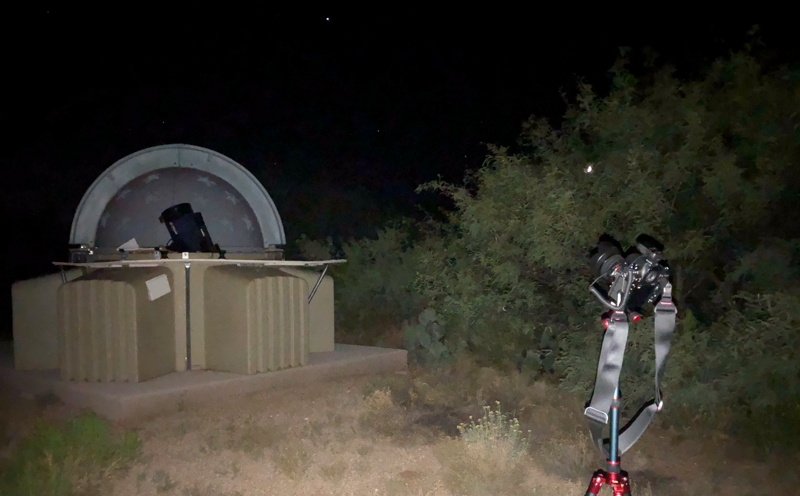Moon, NGC7331 Galaxy;
More 14mm UWA Lens tests, Galaxies
Posted: 2 October 2019
|
Open: Tuesday, 1 October 2019, 1803 MST Temperature: 88°F |
Session: 1388 Conditions: Mostly clear |
Equipment Used:
12" f/8 LX600 w/StarLock
2" 24mm UWA eyepiece
Camera:
iPhone 8 Plus
D850 DSLR
1808 MST: LX600 ON, StarLock OFF, High Precision OFF.
1811 MST: sunset.
1812 MST: viewed Venus, low in the western sky, 102X. 1825 MST: viewed Mercury, also low in the western sky, 102X.
1827 MST: viewed the Moon, 102X. Took this handheld iPhone 8 Plus, afocal 102X, using the iOS Camera app:

Next, viewed Jupiter and the four Galilean Moons, 102X.
1833 MST: viewed Saturn, 102X. Two moons were visible against the still bright twilight sky.
1835 MST: took this handheld D850 DSLR photo (f/4.5, 1/30sec, ISO 1600, White Balance Auto, FL 70mm, cropped) of Jupiter (upper left corner) and the crescent Moon with Earthshine (lower right):

1845 MST: viewed Saturn again, 102X. Four moons were now visible.
1855 MST: this handheld D850 DSLR photo (f/5.6, 1/4sec, ISO 1600, White Balance Auto, FL 300mm, cropped) shows Earthshine and some stars:

1907 MST: viewed NGC7331 (galaxy), 102X. It would be my target object for this night's Extragalactic Supernova Project. Mounted the D850 DSLR at prime focus, focused on Altair, and locked the mirror.
1930 MST: High Precision ON. Slewed to NGC7331. 1931 MST: StarLock ON.
NGC7331 (galaxy), StarLock autoguided, 5 minutes, ISO 6400, WB 4550K, cropped:

No supernovae were detected in the image.
1941 MST: StarLock OFF, High Precision OFF.
I then began preparing to do some more sky astrophotography tests with my new Rokinon 14mm Ultra Wide Angle (UWA, rectilinear) lens. (See my previous report for the first photos I did with the new lens.) I set up the D850 DSLR with 14mm lens north of the observatory:

Jupiter is at the top in the photo with the crescent Moon in the tree behind the camera.
This night's tests were to determine the maximum exposure time before trailing due to the Earth's rotation became evident. I used the PhotoPills iOS app as a guide; it said 20 seconds would be good. And 20 seconds it was. Unlike the previous night's Milky Way photo which was in portrait orientation, this night I had the camera in landscape orientation. This photograph of the southern sky (and observatory) was untracked, f/3.5, 20 seconds, ISO 5000, FL 14mm, WB 4550K:

I then pointed the camera at the Great Square of Pegasus in the eastern sky. This photo (untracked, f/3.5, 20 seconds, ISO 5000, FL 14mm, WB 4550K) shows the Great Square of Pegasus in the center, the Milky Way along the left side, the Double Cluster (open star clusters), the Andromeda Galaxy (M31), and if you look closely, the Triangulum Galaxy (M33). There is also an Earth orbiting satellite at the right. Click on the photo for a larger version with labels.

Click or tap on image for larger version with labels
2013 MST: returned to the observatory. Took a final look at Saturn, 102X.
Ended the session as the next day would be busy one.
2019 MST: LX600 OFF.
|
Close: Tuesday, 1 October 2019, 2032 MST Temperature: 67°F |
Session Length: 2h 29m Conditions: Clear |
Comments are welcome using Email. Twitter users can use the button below to tweet this report to their followers. Thanks.
Cassiopeia Observatory Home Page
Copyright ©2019 Michael L. Weasner / mweasner@me.com
URL = http://www.weasner.com/co/Reports/2019/10/02/index.html
